Google Pixel 3a Review: The MacBook Air of Smartphones

Most phones are judged on 4 things:
- Build Quality
- Performance
- Camera
- Software
If you buy an $800+ phone then you can usually get all of those but spend any less and you’re going to have to compromise. The $400-$700 phone market is interesting because it’s full of phones that are making compromises to appeal to the most people while sacrificing enough to turn a profit. In most cases, phone makes will stuff the bet sounding chips into their phones and will skimp on build quality, software, and the camera. This gets headlines like “a top-of-the-line processor in a mid-range phone!” headlines and surely moves some devices from tech enthusiasts.
Google chose to go a different route as I think they are the only major phone maker who has leaned 100% into the camera and skimped on raw performance. As a result, they have created a midrange phone that’s hard to compare to anything else.
I think that the Pixel 3a has immediately made it hard for me to recommend anyone looking for a midrange phone look at anything else right now. If your budget is $400 then this is a no-brainer, and even if you’re willing to spend a little more and you bring the OnePlus 7 Pro into play, I think this phone will hold its own very well for a lot of people.
That said, this is not the phone for me personally, nor is is a “flagship killer.” Let’s take a look at why that is and if the compromises it makes are the right ones for you.
Camera
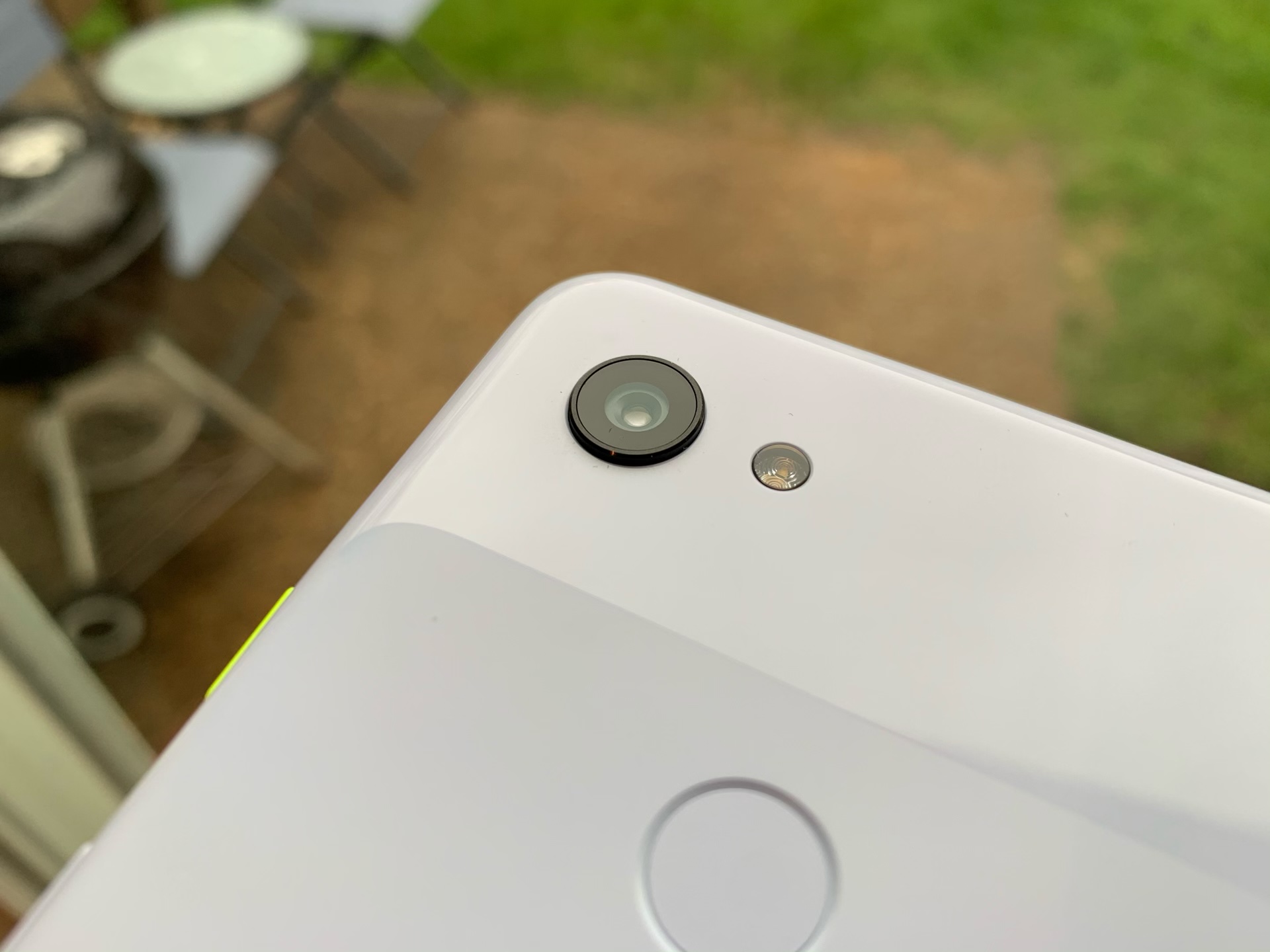
We have to start with the camera because that’s the simgular thing that makes this phone the most interesting. There is literally no compromise here as Google put in the same back camera that they have on their $1,000 flagship. Basically, if you think the Pixel 3 takes the best photos of any smartphone, then the Pixel 3a takes exactly those same photos, so you’re going to love them.
I’ve compared this camera to the iPhone XS and despite liking the photos from the iPhone more, the fact I’m comparing the cameras on a $400 phone to a $1,000 phone and they’re basically neck-and-neck is a huge compliment to the Pixel 3a.
This review is going to be read mostly by iPhone users, so here’s how I’d say the cameras stack up to Apple’s latest iPhones (which again, cost 2-3x more):
Just like the iPhone, you can basically trust this camera to get at least a good photo every time you snap an image. I miss the telephoto lens from my iPhone, but I also appreciate having Night Sight, which adds a whole new type of photo I can take.
If I had to simplify it way down, I’d say I’d prefer to use the iPhone during the day and the Pixel at night. The iPhone gets incredible photos during the day, and I think its HDR capture is way ahead of Google here. As I’ve said many times now, Google’s camera algorithm “optimizes for drama” which can be good, but can also lead to photos that look artificial or lose data due to the extra contrast applied to each photo. Here’s an example:
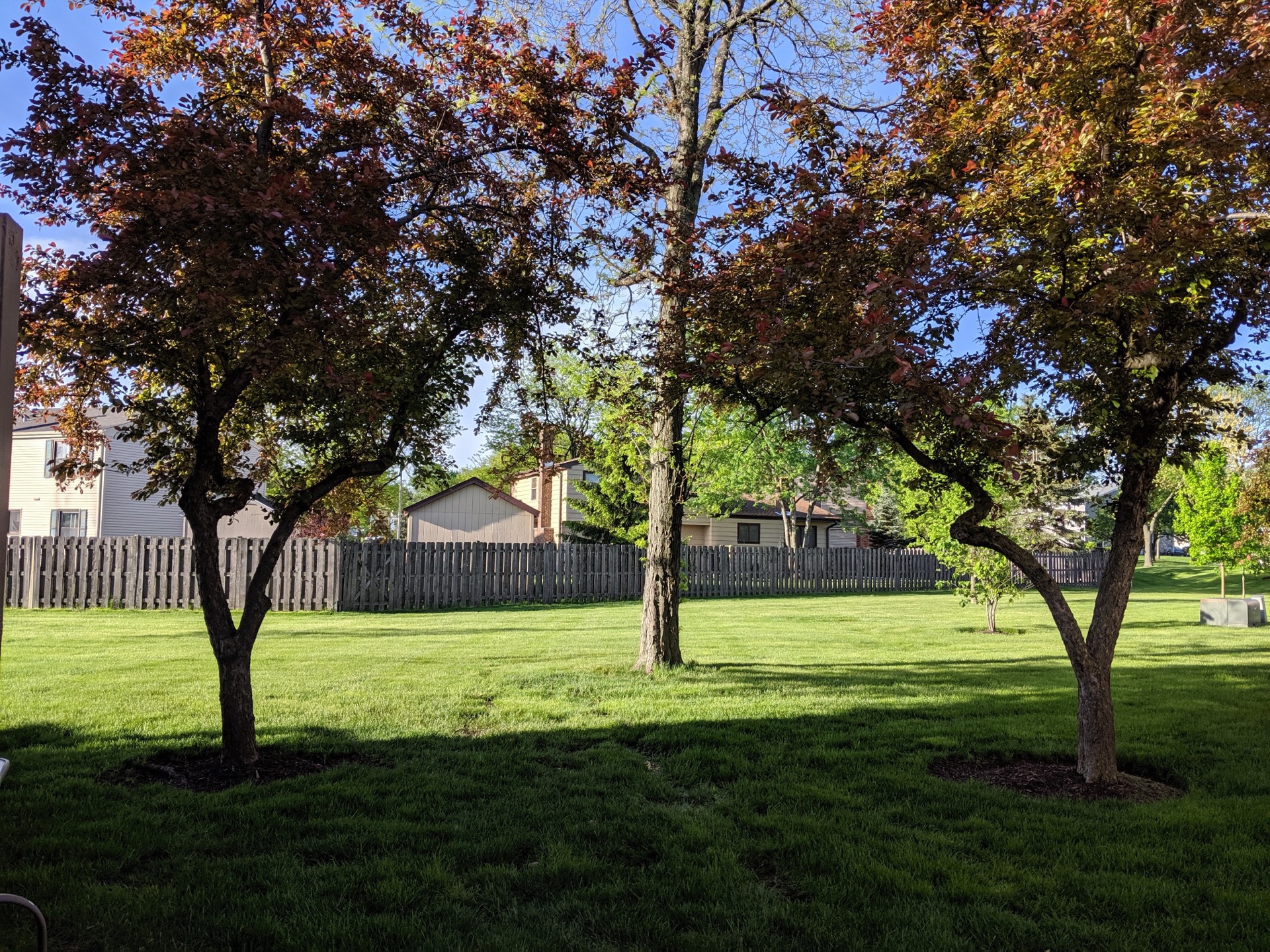
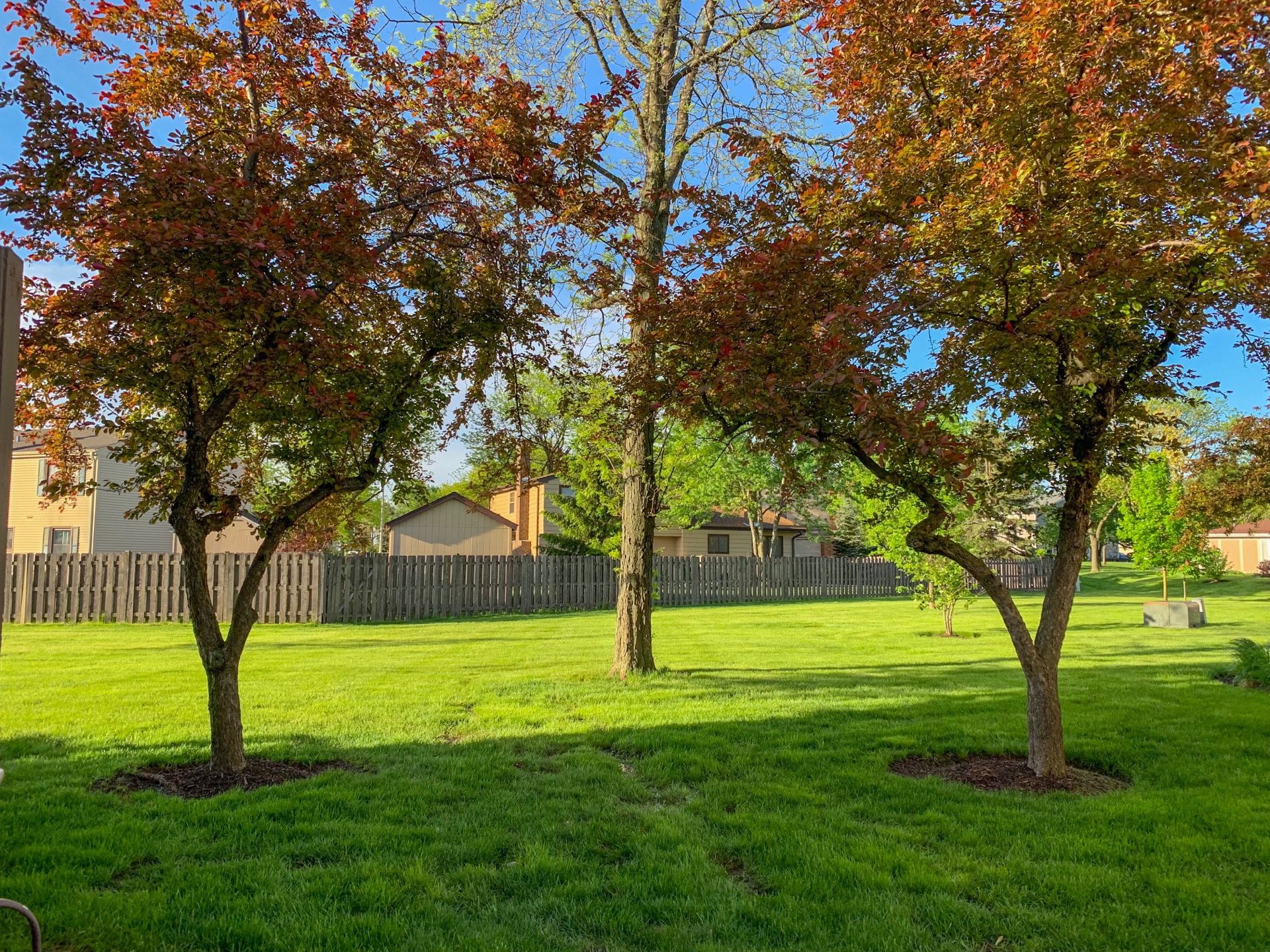
Which of those photos do you prefer? People will differ on this, but I greatly prefer the bottom photo, which was taken on the iPhone XS. The Pixel 3a image is crushing the shadows to create an image that looks decent, but (a) removes details that I can’t get back in editing, (b) does not reflect what this actually looked like in real life, and (c) is less saturated than what made the scene look so nice in real life.
There was also a time I switched my profile photo in Slack at work to a selfie taken on the Pixel 3a and people came out of the woodwork to ask me how many Photoshop effects I applied to that photo because it looked super fake. I had to tell them that none were applied and that’s just how selfies on the Pixel look. I ended up changing the image.
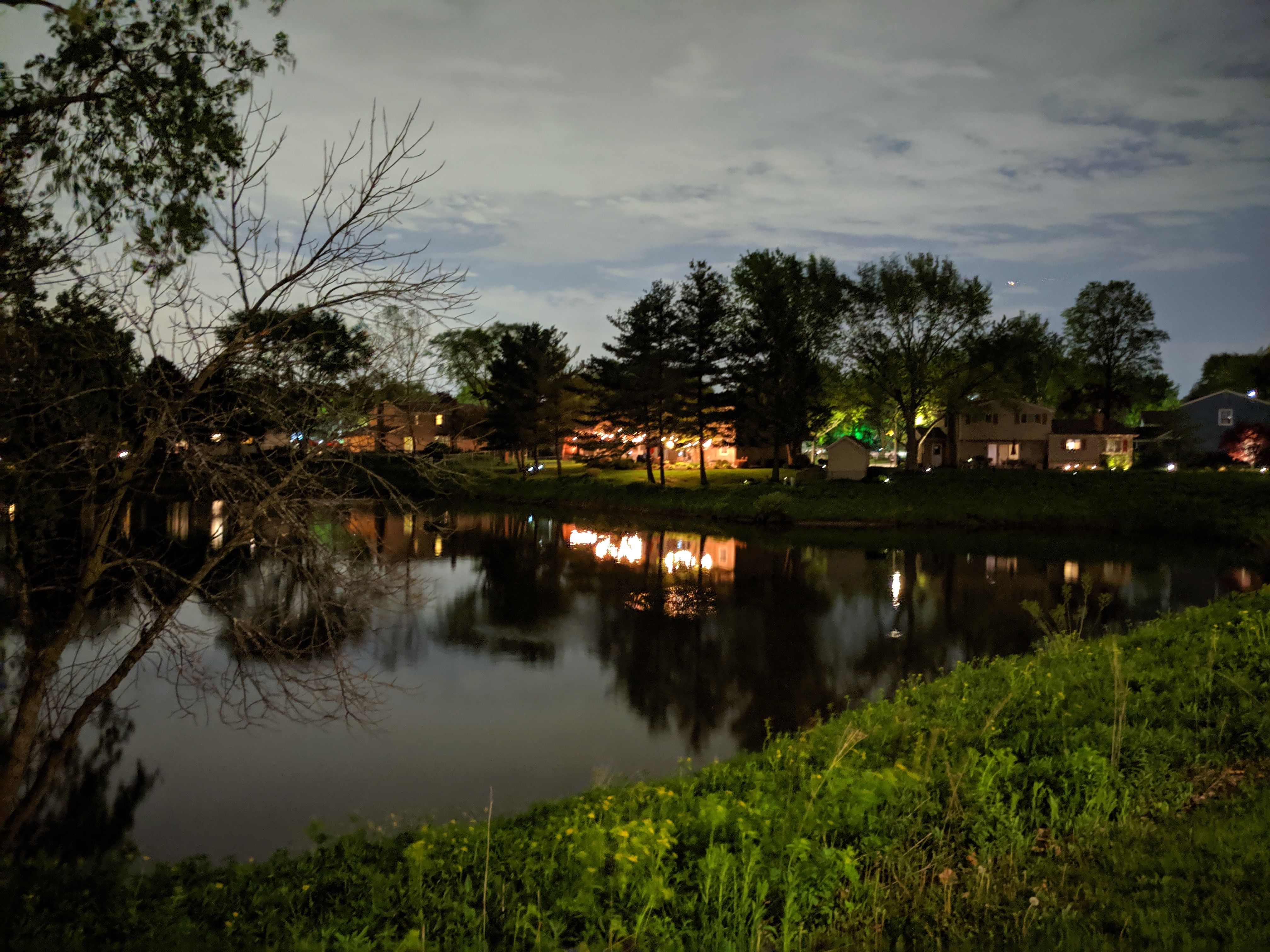
At night time though, I’ll take the Pixel 3a every time. In the standard camera mode it does pretty similar to the iPhone, although the iPhone usually has better white balance at night. But the Pixel separates itself by having a solid flash mode as well as Night Sight, which gives you another option to get a photo if the main shooting mode isn’t cutting it.
Moving past stills on the back camera, we get to places where I think the Pixel 3a falls well behind the iPhone. The selfie shooter is fine and has a wider angle lens than the iPhone, but I think this wider lens produces less-flattering selfies as people’s faces are shaped weird. This is the nature of wide angle lenses, but that wide angle lens also makes it easier to get selfies with more of the background in them or to cram more people into a shot.
Video on the Pixel 3a is quite good, although I’d say it falls well short of the iPhone XS and even the Galaxy S10e I used before this phone. That said, the 4k 30fps footage looks very good and Google’s stabilization is really solid. I don’t think it’s best in class, but it’s damn good video that you’ll enjoy watching.
This is what I remind you that this phone costs less than half of the iPhone XS, barely over a third of the XS Max, and basically exactly half of the XR. The fact that I’m splitting hairs here with $1,000+ phones is a victory in and of itself for the Pixel 3a. This is truly a no compromises camera for a phone in this price range and it’s what sets this phone apart from the rest of the mid-range market. Frankly, this is the only mid-range phone I could ever use as my daily driver for any extended period of time since the camera is so important to me. Kudos, Google.
The Build
The Pixel 3a absolutely feels like a less expensive phone. The plastic body is light in the hand and feels good, but you don’t think of it as a “precious object” like you can with some of these more premium phones. This is totally fine, as phones in this market don’t need that premium feel to bring value, but it’s worth noting.
Despite the less luxurious feel of the phone, it’s built well and feels quite nice in the hand. It’s a bit slippery and its top and bottom bezels make the 5.6” screen a bit harder to handle than on the bezel-less phones out there, but pretty much everything else is a win here.
The colors are here are great. I got the “Purple-ish” model and the name does not lie, this is just barely purple. Most people think it’s a white phone and it’s not until I tell them and they look closer that they say “oh yeah, I guess it’s a bit purple.” And then there’s the accented green power button that just looks great. It’s a slick and distinct look and I totally dig it.
The Display
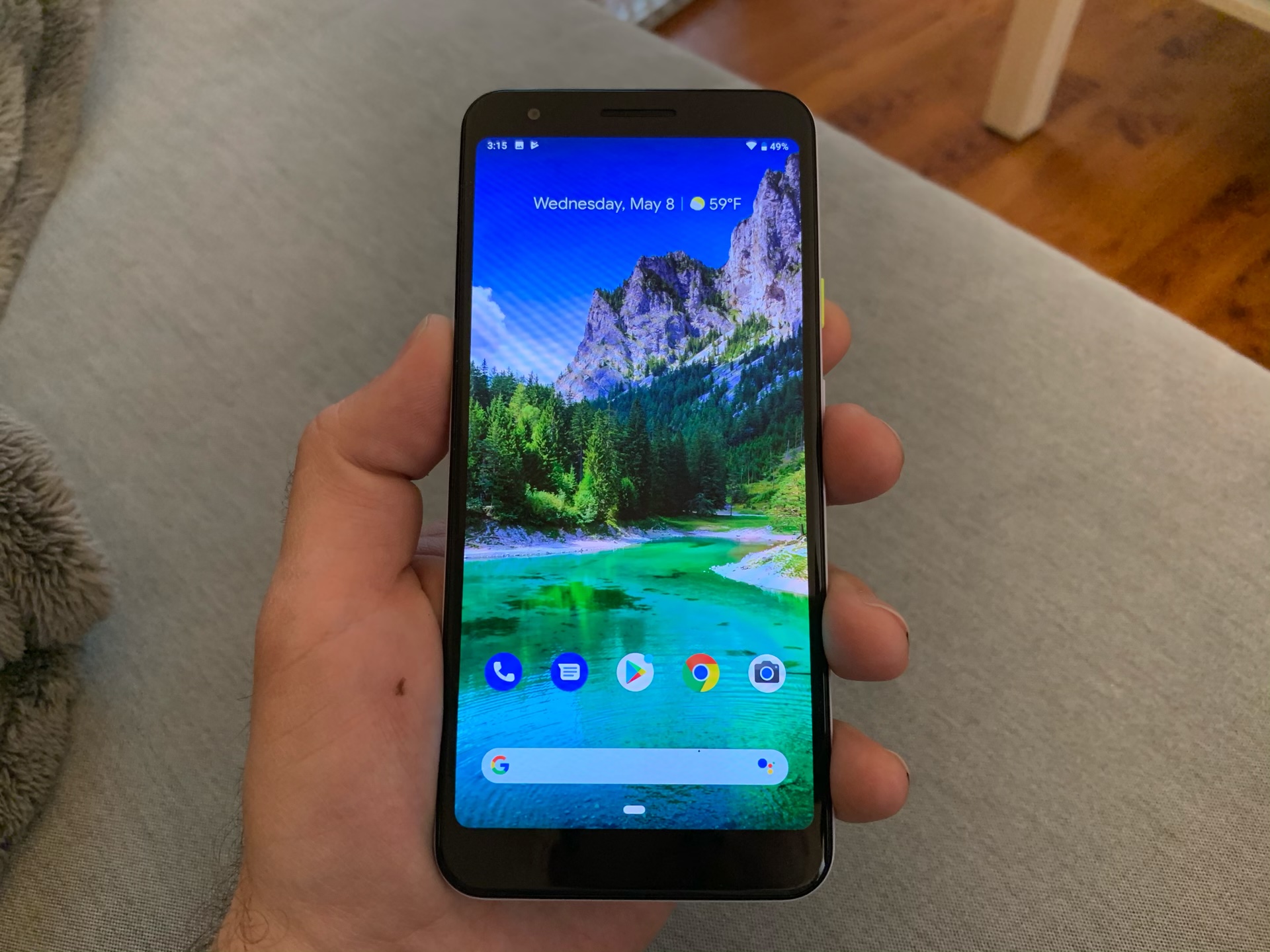
The display is an extra tall 1080p screen with rounded corners. It’s 5.6” and has a pixel density of 441 pixels per inch. This is basically the same as the iPhone XS and much higher res than the iPhone XR. The screen just looks fine overall though. It’s a good screen, but not a great one. Colors appear pretty accurate, but are boring when set side-by-side with higher end devices. This isn’t something you’ll notice much when using the phone like normal, but there are fewer “wow” moments here.
The biggest problem with the display is using it in sunlight. It’s not terrible, but it does not seem to get as bright as the iPhone or Galaxy phones I’m used to and it becomes difficult to see outside.
One last note on the display, this phone has what I consider the best always-on display functionality in the game. It looks nice, displays notifications well, and has the flat-out brilliant “now playing” feature that tells you what song you’re listening to1.
Fingerprint Reader
The fingerprint reader on the back of the phone is top notch. It’s fast and seems quite accurate. In the spectrum of authentication methods, I prefer face unlocks over anything else, but if I have to have a fingerprint reader, I prefer them on the front of the phone, then on the back, and then on the side. The Pixel 3a has it on the back, so it’s not my favorite method, but it’s fine. This is what I said in my Pixel 2 review and it holds true for this phone as well:
People say this location is great because it’s were your index finger naturally is when you’re holding the phone, but my index finger simply does not rest there when I’m using the phone. I can put my finger there easily enough when I pic up the phone to unlock it, but my hand shimmies down the phone to actually use it. I’m about an inch below it and need to stretch to reach it, which is not comfortable.
Battery Life
Full disclosure, I do not have real battery life tests since I have not moved my SIM card over to the Pixel 3a, but I can say that it holds a charge better than my Galaxy S10e which is also in WiFi-only mode right now. Here’s what I said about that phone:
Coming from the iPhone XS, this is pretty much what I’m used to.
So yeah, if you have an iPhone XS then the Pixel 3a will probably get slightly better battery life.
Buttons and the Squeeze

I mentioned the buttons in passing already, but they are all on the right side of the phone which I quite like and they are nice and clicky. The iPhone has the best buttons in the game, but the Pixel 3a has good buttons that hang with the best of them.
And then there’s Google’s “active edge” feature which lets you trigger Google Assistant by squeezing the phone. I hate this feature. Despite setting it to every sensitivity option and trying my best to work with it, I accidentally trigger it about 10x more than I do so intentionally. It just makes me feel like I need to baby my phone and not grab it too hard, lest I get Google Assistant asking me what I want to do when all I wanted was to check the time. Maybe you’ll enjoy it, but for me it’s never convenient enough to make up for the constant annoyance it causes for me.
I/O and Charging

There is a USB-C port on the bottom of the phone which does all the USB-C things you’d expect, but you’ll probably just be used for charging, which is fine. I’ll also mention that this phone does not have wireless charging and I miss that feature more than I realized I would. My life is all in on wireless charging, with my iPhone (and Galaxy) sitting on a charging mat at night and a charging stand during the day. The Pixel 3a made me add wires to these setups and I personally hated it. Outside of reviewers like myself, I don’t know who else is going to go from a wireless-charging phone to the Pixel 3a, but it’s hard to do back.
And last but not least…well, actually yeah, least…there is a headphone jack on this phone. Just like wireless charing, my whole life has moved on from wired headphones, so this port was basically useless for me, but I’m sure plenty of people will enjoy having it. I do need to talk about its placement though, which is on the top of the phone and seems stupid.
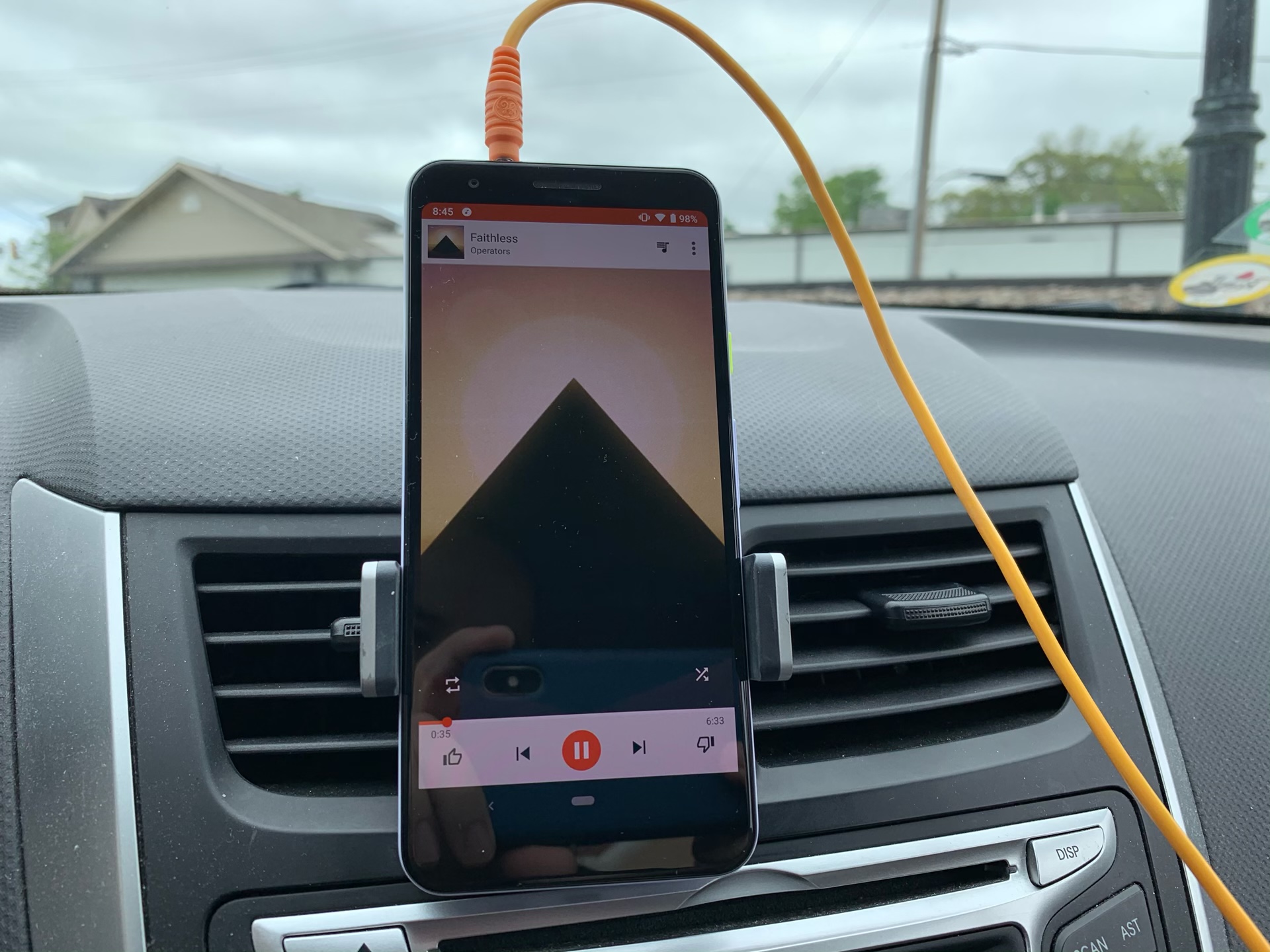
Why, Google, why?
Storage
This story is pretty simple as the 3a and 3a XL only come in one storage size: 64GB. I think this is fine and makes perfect sense for the price point they’re hitting. Would I love more storage? Sure, but 64GB is going to get the job done for most people and I think the only real problem here is that you can’t throw another $100 at this phone to upgrade to more if you want it. There are no higher storage options nor is there a micro-SD slot for additional storage.
Android does a pretty good job of not absorbing all of your storage so this has been okay for me so far. I have been using this for my podcasts, music, audiobooks, and games, and I currently have 43GB free.
Performance
If you were waiting for me to get to the MacBook Air comparison from the title, then wait no longer. This is where Google saved some cash and you can tell it’s not a top-of-the-line phone when it comes to speed. That sounds like a dig, but it’s not meant to be. Some people want/need a specced out MacBook Pro, but many people are perfectly fine with a MacBook Air. Different products, different categories, and different customers.
The Pixel 3a ships with a Snapdragon 670, which doesn’t mean a whole lot on its own, but the important bit is that this benchmarks a tad slower than the 2017 Google Pixel 2. This is according to Geekbench and all the web benchmarks I could throw at it. In terms of iPhone speeds, that’s somewhere between an iPhone 6 and 6s for single core and and close to the iPhone 7 for multicore. If you were curious, the iPhone SE benchmarks 33% faster than the 3a in single core, and is a little slower in multi-core.
But benchmarks only matter so much and real world performance is what is actually important in a phone. Sadly, the benchmarks tell the story pretty well here as the Pixel 3a feels very much like a slower phone than the higher end options out there. This is one of those things that you have to let sink in for a while, as most phones, including this one, feel perfectly fast up front. Watch literally any review of any phone ever and they’ll say something like “and it handled everything I threw at it without any trouble.” This line bugs me so much and is the sort of thing you say after using a phone for a few hours.
After 3 weeks with the 3a I can confidently say that this will do anything you want it to, but it’s going to do it all slower than you’ll get with a higher end phone, as well as many of the similarly-priced budget phones out there.
Apps usually launch quickly…until they don’t, and animations are basically always a bit choppier than I’d personally like. None of this is a disaster, and you can absolutely get your work done on this phone, but the difference between a high end Android phone and this phone is absolutely noticeable.
But here’s the thing about this phone’s performance: if you are a more average customer and are getting your phone from a carrier, then this phone contends much better. Look at what Verizon, T-Mobile, and Sprint have in the $400 range and this is going to keep up with or beat most of those options. It’s only once you get into some of the Huawais and Pocofones on Amazon that you get phones that really smoke this thing in terms of performance. Of course, getting those phones means a far worse camera and pretty darn objectionable software layers over Android. If you care most about power, then the Pixel 3a isn’t for you, but if a great camera is worth tolerating acceptable speeds, then the 3a is really hard to beat.
Software
Bringing up the rear is software, not because it’s unimportant, but because it’s simply not going to be my favorite part of any Android phone. Also, as a Pixel phone, we don’t have much to talk about since it’s really just stock Android.
Ultimately I think this is a good version of Android but it lacks some things I’ve grown to like about, and I can’t quite believe I’m saying this, Samsung phones. I miss the lock screen customizations Samsung offers, I think the dark mode is better, I miss the health tracking features, I miss the UI tweaks of One UI, and I even miss Bixby routines.
But the Pixel line is not all about having tons of features right out of the box. You can download apps to add a lot of power to the device, so it’s not that big of a deal. And Google would probably tell you that Google search and Assistant already give you tons of power on their own.
One of the great things about Pixels is that they are not overwhelming and I love that about them. As far as Android phones go, the Pixel 3a has a good stock experience, not a big one.
Recommendation
If my phone budget was sub-$500 then the Pixel 3a would absolutely be the phone I would buy. I appreciate speed and love having it in a phone, but the most important to thing to me is a camera, and it’s what has prevented me from using cheap phones as my “daily driver” for very long. I need my phone to have a great camera and the 3a delivers here like no other phone in the price range. Despite my gripes about performance, I’d rather trade that for a good camera any day of the week.
I’d also recommend the Pixel 3a to any iPhone user who is Android-curious. I think you can get a good idea about Android from this phone without breaking the bank on a flagship. I suspect this will not convert you and make you want to sell your iPhone, but if you have the budget to have a second phone, then this is a very good option.
If you must have more speed then something like the OnePlus 6T is a good option and will cost you $100-150 more. And if you want to spend what flagships used to cost before they got insane, the iPhone XR and Galaxy S10e are great choices in the $650-750 range. I’ve never used it personally, but if you want to spend a little less than $400 and get better performance, then the Pocofone F1 seems to be the winner.
- To clarify, it tells you what song is playing in the world around you, not the song playing on your phone itself. ↩


